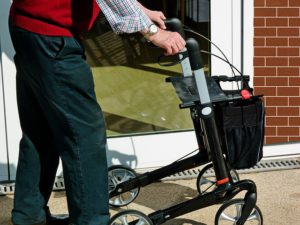I have been using walkers for many years and I want to give you some insights into my experiences with walkers.
Standard walkers without wheels
These standard walkers do not have two front wheels. While these walkers are not necessarily heavier than walkers with two wheels, they are more difficult to move. I have found that walkers with two front wheels make the walker easier to move.
Balance 
My walker without wheels was located in my den, and I would use it to help me maintain a fish tank that I once had. Ironically, the walker had one leg that was shorter than the others, which made the walker somewhat unbalanced. At first, I almost fell with the walker, but in time I learned to compensate for the short walker leg. It may have been possible to get a spare rubber walker foot for the walker leg. Typically, the walker feet have a metal ring that helps to maintain the walker’s rubber feet. Adding this may have helped balanced the walker, although I admit that I never did this.
Hand grips
All walkers, both with or without wheels, have rubber or plastic grips. I found that the rubber grips gave me a more secure grasp on the walker, however, rubber grips after a few months were notorious for moving to an inconvenient place on the walker’s handle bar. They could be moved back in place, but only with a substantial effort.
Rolators
Household walkers with and without wheels cannot be used for a substantial amount of walking outside the home. The rubber feet get worn out very quickly on concrete and asphalt. You will find that you are almost constantly putting on new rubber feet. A task which is neither easy nor convenient because the rubber feet are typically tight around the legs of the walker. Invariably, you will find it necessary to purchase a rolator. They come in different colors, sizes and styles. They often have four wheels.

Brakes
How do you get any stability from a device that has four wheels? The answer is that they have front and back brakes. When you need stability, you grab the front and rear hand brakes for dear life, otherwise you are likely to fall. The hand brakes are very similar to the hand brakes on a ten speed bicycle. Unfortunately, as the wheels wear down, and they will on concrete and asphalt, the hand brakes, like the hand brakes on a bicycle, often need adjustments. This is why you grab both hand brakes for dear life. It is likely that one or the other will be misadjusted and you will need all the remaining brakes to stop.
Shopping
Rolators are often useful for shopping. I have used a rolator many times to do shopping. However, when one or more of the brakes became misadjusted, it was not unusual to find some or all of my bags on the ground. This was a common occurrence for me at the local CVS. It was not easy for me, or any disabled person, to adjust the brake system, but I often adjusted the brakes.
Inflatable items
Since we are on the subject of similarities to a bicycle, it is timely to note that the wheels of a rolator do not have to be inflated. However, some power wheelchair tires do need to be inflated. My wife and I have a son, and believe me, it is difficult for a disabled person to inflate bicycle tires, footballs and basketballs (all of which I have struggled to do).
Curbs
Another issue is getting up and down curbs with a rolator. This is where good brakes are essential. You need to grab the hand brakes and balance yourself with the rolator. If everything does not work just right, you are likely to fall. I recognize that you should find the curb cut to enter and exit the street. I realize this is often easier said than done. Just be very careful.
Conclusion
I hope this post has helped people understand the trials and tribulations of dealing with standard walkers and rolators.


